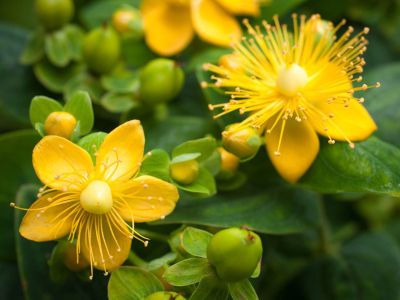Can I Grow St. John’s Wort?
If you live in USDA plant hardiness zones 5 or 6 to 10 and have a partially shaded site, you can probably grow St. John’s wort. The plant isn’t particular about the soil type. It grows well in sand, clay, rocky soil or loam, and tolerates acidic to slightly alkaline pH. St. John’s wort adapts to both moist and dry soil, and even tolerates occasional flooding. It also withstands drought but grows best with irrigation during prolonged dry spells. You won’t find a plant that will thrive in more situations.
How to Grow St. John’s Wort
Growing St. John’s wort herb in a location with too much sun can lead to leaf scorch, while too much shade reduces the number of flowers. The best location is one with bright morning sunlight and a little shade in the hottest part of the afternoon. If your soil isn’t particularly fertile, prepare the bed before transplanting. Spread about 2 inches (5 cm.) of compost or rotted manure over the area and dig it in to a depth of at least 8 inches (20 cm.). Transplant the shrubs into the garden, setting them at the height at which they grew in their containers. They grow only 1 to 3 feet (30-91 cm.) tall with a spread of 1.5 to 2 feet (46-61 cm.), so space them 24 to 36 inches (61-91 cm.) apart. Water slowly and deeply after planting and keep the soil moist until the transplants are well-established.
St John’s Wort Plant Uses
St. John’s wort makes an attractive ground cover and soil stabilizer. Once established, the plants need no care, and this makes them ideal for out-of-the-way locations. You can also use it as an edging or to mark boundaries and pathways where you don’t want to obstruct the view. Other uses include containers, rock gardens and foundation plantings. The species plants self-seed and can become weedy, particularly common St. John’s wort (H. perforatum). Ornamental cultivars are well-behaved plants that aren’t likely to grow out of control. Here are a few cultivars you might want to try:
H. x moserianum ‘Tricolor’ – This cultivar is noted for its variegated foliage with a rainbow of color that includes red, pink, cream and green. H. frondosum ‘Sunburst’ – This is one of the cultivars that can take winter temperatures down to zone 5. It forms a bushy mound up to 2 feet in diameter. The Hypearls series includes the cultivars ‘Olivia’, ‘Renu’, ‘Jacqueline’ and ‘Jessica.’ This series is one of the best for hot climates. H. calycinum ‘Brigadoon’ – The flowers on this cultivar aren’t as conspicuous as some of the others, but it has chartreuse foliage that turns golden orange in bright sun.
